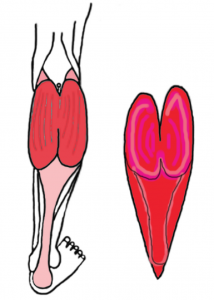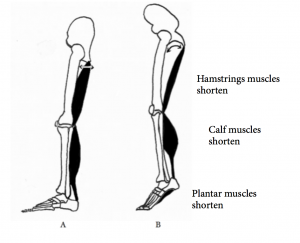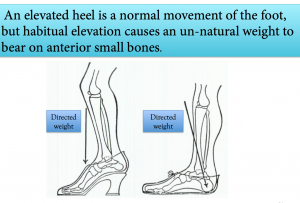 The calf muscle and the heart.
The calf muscle and the heart.
According to Dr. Simon Wikler, MD, the calf muscle (primarily the gastrocnemius) can be considered the second heart of the body. In his decades of experience in working with feet he concluded that the gastrocnemius is anatomically designed to function as a pump when we walk and run which assists the veins to deliver de-oxygenated blood back to the heart to be re-oxygenated. He therefore, attributed the movement of this calf muscle to be a vital component in keeping the heart healthy–suggesting a supple calf muscle is best to maintain strength and to ensure its ability to contract and relax to the fullest extent.
Dr Wikler linked shoes to being one of the main contributors to the development of foot problems and heart disease. He explained, if shoes are too small, too stiff, and/or too narrow, it will inhibit the normal pumping action of the calf muscles because there isn’t enough room in the shoe to allow for the muscles to engage to their fullest potential. He also asserted, with continued use of shoes that do not fit correctly, the calf muscles become shorter and bulkier, and eventually become inert. With less activity the fascia that surrounds the muscles of the calf become more dense, which begins to limit their ability to perform their normal function– moving the feet. Subsequently, restriction of blood flow to and from the heart could start to develop. What’s worse, because feet are so malleable, most people aren’t aware they’re wearing shoes that don’t fit.
Lets consider other factors that may compromise the integrity of calf muscles …
Fore-foot running: Is it a good idea?
The idea of decreasing stress on the feet is fantastic. However, engineering a running form (fore-foot) to direct weight away from the heel(which is designed to bear weight), and thrusting this responsibility to the gastocnemius muscle(which is designed to propel the foot) in an effort to “cushion” the blow as the foot makes contact with the ground, seems contrary to normal foot function. Running this way would be expected if we were cats or dogs whose anatomy is designed for this kind of impact. The appearance of the enlarging calf muscles may give one the notion these bulkier muscles are stronger, but the opposite is true. With a shorter span to contract this muscle pulls harder on its attachment to the heel via the achilles tendon, and becomes more vulnerable to #calf blow-out– a common occurrence among athletes. In the long run the perpetual stress caused by this contriving fore-foot locomotion may cause complications, not only in the calf muscles that are taking on unusual demand and function, but to the rest of the body–especially the heart and lungs.
The calf muscle and heart connection have lead me to wonder about its relevance to the case of beloved, utra-long distance runner, Micah True, the lead character in the book “Born to Run” by Christopher McDougall, who passed away at the early age of 58 of heart disease.
Follow along as I explain my cautionary rationale against the fore-foot walking and running trend.

The two images above show the side-view of the pelvic girdle, femur, lower leg, and foot, with muscles that attach to them. In Illustration “A”, notice the arrow that indicates a neutral position of the pelvis, and the relaxed position of the muscles that attach to the back of the leg and foot. Illustration “B” shows the position of these muscles when standing on the fore-foot. Notice the tilt of the pelvis, and the shortened calf muscle. Although the arrangement of the muscles in Illustration “B” is normal during different phases of walking and running, this chronic, elevated position may cause harm to the body–and yes, to the heart, and other organs.

Stress fractures are common when the fore-foot is subjected to relentless weight–especially while running, which imposes an impact of 3-4 times the weight of the body on the metatarsal bones with every step.
For the reasons listed above it should be understood that the chronically, lifted position of the heel while walking or running could lead to health problems in the feet and in the rest of the body. In my Structural Reflexology® practice, I’ve seen the ramifications first hand with athletes and non-athletes who seek and receive lasting solutions to their foot, leg, and back pain. The effective and efficient results of receiving a Structural Reflexology® session emerge and are maintained once the fascia surrounding the contractured calf muscles are released, the ensuing foot joint tension is resolved, and the individual is fitted with shoes that allow the calf muscles to move the feet with ease. Athletes have reported to having great improvements in their running time and in their athletic performance, and clients who have suffered with heart palpitations have elatedly proclaimed their symptoms have subsided.
In most cases these simple applications allow the calf muscles to find their normal function again, and this in turn, improves the blood flow from the foot and back to the heart.
Click on the book to order your copy of Put Your Best Feet Forward!
Archives
- October 2024
- December 2023
- October 2023
- March 2022
- July 2021
- August 2020
- May 2020
- April 2020
- February 2020
- January 2020
- December 2019
- November 2019
- October 2019
- August 2019
- June 2019
- May 2019
- April 2019
- January 2019
- December 2018
- October 2018
- September 2018
- July 2018
- June 2018
- April 2018
- February 2018
- December 2017
- November 2017
- October 2017
- September 2017
- August 2017
- July 2017
- June 2017
- May 2017
- April 2017
- February 2017




3 Responses to The calf muscle and the heart